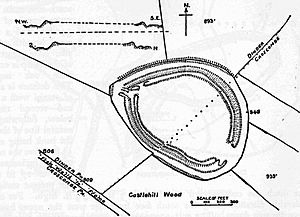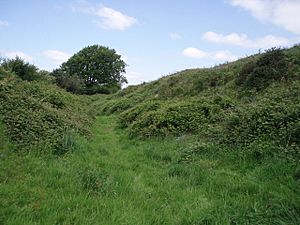Maesbury Castle facts for kids
Quick facts for kids Maesbury Castle |
|
|---|---|

Plan of earthworks at Maesbury Castle
|
|
| Location | Croscombe, Somerset, England |
| Area | 2.5 hectares (6.2 acres) |
| Built | Iron Age |
| Reference no. | 200279 |
| Lua error in Module:Location_map at line 420: attempt to index field 'wikibase' (a nil value). | |
Maesbury Castle is an old hill fort from the Iron Age. It is found near Croscombe in the Mendip Hills, Somerset, England. This important historical site is now a Scheduled Ancient Monument, which means it is protected by law.
The name Maesbury comes from two old words. Maes means field or plain in an old Welsh language. Burh means fort in Old English. Around the year 705 AD, it was also called Merksburi, meaning boundary fort. This area was a border between the people living in Britain during Roman times and the West Saxons. This was between 577 and 652 AD. A large earth wall called Wansdyke was part of this border.
The fort covers an area of about 2.5 hectares (6.2 acres). It sits high up at 292 meters (950 feet) above sea level. From here, you can see far across the land. You can see the Somerset Levels, Glastonbury Tor, and Brent Knoll. The fort has one main wall, called a rampart, which is up to 6 meters (20 feet) high. It also has a ditch outside this wall. There are entrances on the south-east and north-east sides. There might have been extra defenses there too.
The fort and the land around it are owned by the Stevens' Family. They have been farming in Somerset for over 60 years.
What is a Hill Fort?
Hill forts are ancient strongholds built on hills. They were common in Britain during the Late Bronze Age and Early Iron Age. This was roughly around 1000 BC. People have wondered why these forts were built. Some think they were military bases to defend against invaders from Europe. Others believe they were built by invaders themselves. They might also have been a way to deal with fighting among people. This fighting could have happened because more people meant less land for farming.
An archaeologist named Barry Cunliffe thinks that more people did play a part. He said that forts offered a safe place for communities. This was especially true when tensions led to open fighting. But he doesn't think they were built only because there was a war. They were useful for defense when there were problems. Some forts were attacked and destroyed. However, this was not the only reason they were built.
Maesbury Castle's Location
Maesbury Castle is 292 meters (950 feet) above sea level. This high spot gives great views of the valleys and hills around it. The hill itself is made of Old Red Sandstone. This type of rock is very old, about 400 million years old. It has not worn away as quickly as the limestone around it.


